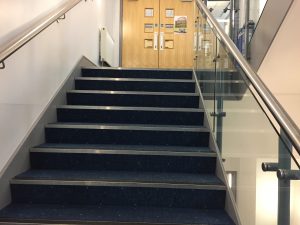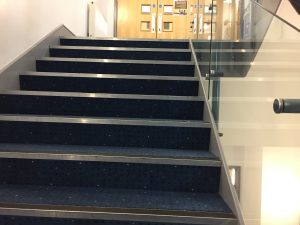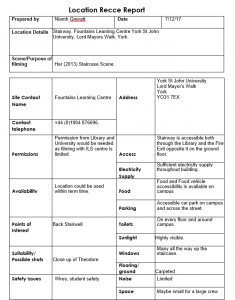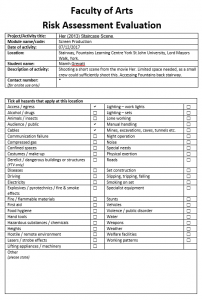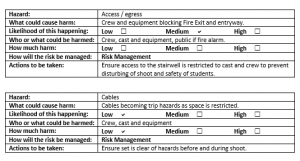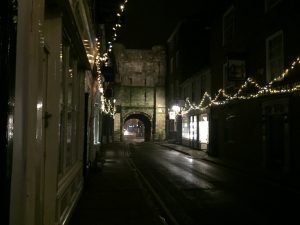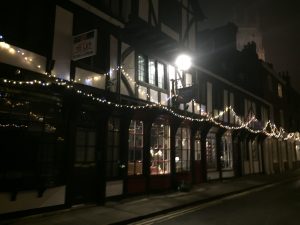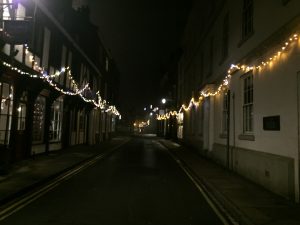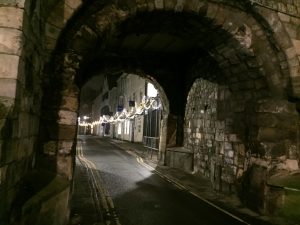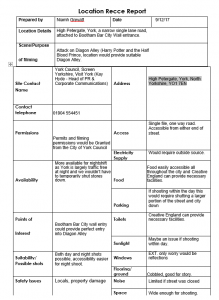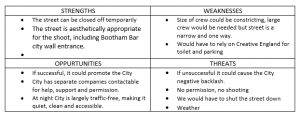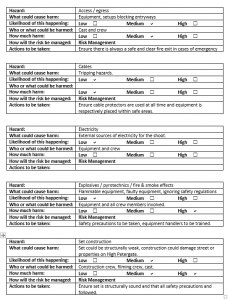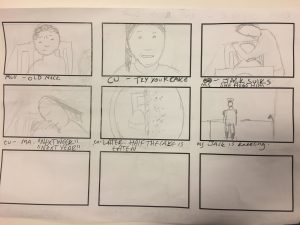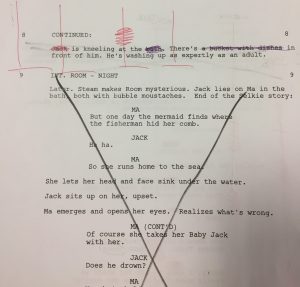Production Blog
For my Screen Production module I was given a list of six tasks and required to produce a production blog to reflect upon the said tasks I completed and artefacts I created. These six tasks consisted of shooting a short film within 48 hours, a production management task discovering the feasibility of two locations after devising location recce’s, swot analysis’ and risk assessments for both. The module also include a Foley sound task, editing a soundless video and a script development task, devising our own shots for a script. I also took part within two group tasks, one a multi-camera recording of a live stage production and a single camera task which challenged us to develop a script excerpt into our own story.
48 Hour Film Task
My first task within the module was the 48 hour film challenge, a group project that asked us to produce a 48 hour short film.The production process began with a task brief that detailed specific criteria that our short film had to comply with. This criteria compiled our 48 hour project to feature a required line, character, prop a the details of these would be given to us at the beginning of our 48 hours. Our initial concept was based upon the mystery and crime genres as it would feature a kidnapping of a young man, taking an unexpected twist to reveal the two characters involved are both willing participants in the attack and the kidnapper is in a relationship with the kidnapee.
At the beginning of the project our group formed and reflected on the constrictions the required elements would produce and referring to the project management triangle, we began a discussion of the task. We examined what components the film making process required, which included having to produce a concept and script whilst ensuring this could be re-adjusted when given our required criteria. We were asked to devise a presentation of the project as this would allow us to outline all details for our production, this included a structure breakdown of our short film into a clear three act narrative. We then devised a synopsis giving our story depth, gathered a prop list, as our project was crime we needed to ensure our prop list was defined early as any use of violence and weapons within our short would need to be authorised. Furthermore gathering a location list in order to ensure our settings were appropriate, for the shoot we used our directors house as our primary location. This location was suitable due to its accessibility, allowing us to shoot locally in a suburban area that allowed for an undisturbed night shoot for our first act and fitting establishing shots for our third act. The presentation also contained our actors list, we chose to use members of our own group alongside personal residence as it meant we wouldn’t need to rely on outside sources. Although our actors were less experienced it allowed us to make efficient use of our limited time and helped to ensure crew availability and access.
Within our group we had devised what roles were necessary for our project, who would do what and why, this allowed us to allocate pre production and production tasks ensuring we were equipped and prepared for the shoot. My role within the project was Lighting, equipped with Lighting experience from previous practical tasks and shoots, I felt qualified and able to effectively light the project. Within my role during the pre-production process I researched lighting for crime, within classic noir crime lighting was used in one point lighting structures in outside scenes to enforced silhouettes and enhance shadows as seen in The Big Combo (1955). For our outside shoot I decided to use only natural and street lighting to enhance reality and artificial light within the phone box to refer back to the use of one point lighting structures in classic crime. In comparison I researched lighting in modern the crime/ mystery genres, films such as Gemini (2017) featured heavy use of neon and coloured lighting. I used this style of lighting within the second act with focus on red lighting at is represented both lust and power, I felt both these stylised use’s of lighting could enhance the projects tone and meaning. On the day my research came in useful because for the night shoot we used almost all natural lighting with minimal artificial lighting for within the phone box. The use of the harsh red lighting within the second act gave the scene a darker, sadistic tone. During this process I referred to ‘Making Short Films, Third Edition: The Complete Guide from Script to Screen’ by Clifford and Max Thurlow for guidance and references when making our short film.
The statement of intent we produced before shooting was finalised after receiving our specific criteria, we were able to integrate this criteria into our shoot through the use of extra props, a birthday sash was used to define the coming of age genre. The required prop, an almost empty bottle, and the required line were “take this you might need it”, were effectively placed and helped give realism to the intoxication of our character. The required character an ‘overconfident expert’ also was easily placed into our short as one of our original characters, our kidnapper was a expert in his craft. The required criteria didn’t affect our intended audience, of young and lgbtq+ people, as our two characters still represented that within the film. They also had no effect on our predefined cinematographic style that relied on short clips and montages to build suspense. Our project was easily adaptable to the specific criteria as we had put effectively organised pre-production, and our concept was simple but also sufficient in its story depth.
Production Management Task
For this task I had to produce two location reports for two separate scenes, one interior one exterior, producing a SWOT analysis for each along side supporting photos plans and completed risk assessment and recce forms.
My first location report is of Fountains Learning Center, I conducted a location recce for Fountains as I felt it would provide an appropriate location for the stairwell scene from 2013 indie Her. This location proved to contains both positives and negatives. The location is a strength in that it is easily accessible within campus, the Fountains Library provides a quiet idealistic set, this set is also open 24/7 throughout most of the school year. Our crew would be able to access food, toilets and parking all within a half mile radius, most of these falling within campus. However weakness come into play as students use the library daily and this project would require shutting part of the center down in order to shoot and this could prevent students from participating within their studies. The location provides and opportunity our crew to shoot on a relatively low budget and if successful would create positive promotion of the university, however if the production were to fail, this could cause negative impact on the university and its image. Shooting at this location could be appropriate and feasible if used productively and efficiently.
My second location report is of a section of High Petergate, York,I conducted a location recce for High Petergate as it aesthetically suit the location of the scene without too much set alteration, Bootham Bar would also provide and adequate Diagon Alley entryway. This location featured a combination of positives and negative, the street was aesthetically adequate but physically constrictive as the crew would net to construct a set along the street and we would struggle to fit a large crew, with equipment and vehicles alongside a collective of extras and cast members. The probability of shooting within this location relies upon a local council, this scene would require pyrotechnics and smoke effects therefore they would have to grant us permission in order to shoot here, producers would have to ensure the professional conduct of the crew and safety of the city and its inhabitants. The power to shoot on location during the day was a strength however it would be on a limited time constraint, with greater noise pollution in comparison to night. When York is largely quiet and traffic is minimal, therefore it would be more feasible to shoot overnight therefore causing less disturbance than a daytime shoot would.
Local city information gathered from VisitYORK.
Foley Sound Task
For this task I was required to, from a provided silent scene, ‘devise and create a multi-layered soundscape’ this was to relate to my own understanding of the clip in relation to its tone, meaning and mood. Challenged with a scene with no sound I had to refer to the use of Foley sound effects, Foley is the recreation and capture of sounds to and establish and enforce reality within media artefacts. I referred to copyright free sources Freesound.org, Bensound.com and Premiumbeat.com for all my sound effects and audio clips. The clip followed a young girl on a road trip with her father with the establishing shot featuring grass and sand covered banks and hills. Their vehicle appears on screen almost instantly, driving onward through the banks past the camera. The initial audio track I laid over the clip was a recording of seagulls and sea breeze on a windy beach, as I believed this related to the scenes setting and created diegetic ambiance. I added the captured audio of a passing vehicle to heighten the realism of the clip, additionally adding Foley captured within a moving vehicle as the shot changed to the pair travelling within the car. I edited this effect, copying and reversing it in order to reuse it without heavy repetition, likewise using this technique on the ‘huff’ effect I placed over the father during this scene. To continue developing a realistic clip I added effects including the scratching of hair and cloth as the father ruffles his daughter’s head and clothes. For the following exterior shot’s I added the effect of an FM radio tuning and an upbeat fun audio track from Premiumbeat.com, as the clip featured two exterior wide shots that I felt could use more depth. I overlaid this with a non-diegetic music clip from Bensound.com, this was a softer piano piece that I felt suitably reflected the melancholy shift in the girl’s tone and expression and the introduction of the whale and the connection between the two. I wanted to enforce a more immersive sound for the whale clips, by using water effects, captured below the surface and whale noises created from a deep-sea echo. For the last clip I imported ocean noise, the sound of gravel due to the car pulling over and engine noises. I used the soft piano piece to move with and play out the scene as it aided the tone I was creating. The sounds I used within this video, I chose due to their aid in creating tone and reality within the clip.
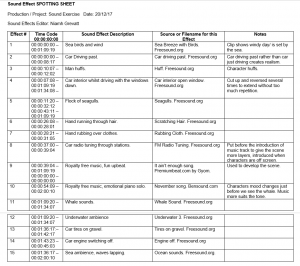 A sound spotting sheet I created and referred to in the creation of this artefact.
A sound spotting sheet I created and referred to in the creation of this artefact.
Whale Rider Foley Task. from Niamh Grevatt on Vimeo.
Script Breakdown Task
For this task I was required to extract a chosen scene, from any film, and devise my own responsive shots to the script, conducting a storyboard, breakdown sheets and annotated shooting script. I chose to excerpt a clip from the Academy Award winning 2015 film ‘Room’. The scene I chose to re-imagine was a short scene between Jack and his mother on his fifth birthday, where Jack is gifted with a birthday cake but cannot understand why it contains no candles. I chose this scene, and this film, due to its simplicity that does not underestimate its ability to explore and present a deeply meaningful story. It’s simplicity allowed me to expand upon the previous content, exploring how different shot sizes, styles and lengths can alter the impact of a character’s emotions and actors performance. The scene tells an audience a vast amount of information within 60-90 second period, in that time it is revealed how long Jack and Ma have at least been captives, they survive with the bare minimum (cake, Sunday treat) and the bond between the two as they rely only on each other for care and affection. I felt my re imagined scenes use of limited space and props re-affirmed the vacancy of grandeur and freedom in these characters lives. For this task I referred to ‘Multimedia Storytelling for Digital Communicators in a multi platform world’ (Ginter, 2016) and his explanations of storyboards and shot types to ensure correct use of terminology and structure (pg 247-251).
Group Live Task – Patience by Gilbert & Sullivan
For this Screen Production task I worked within a group formation on a live multi-camera shooting of ‘Patience’ by Gilbert & Sullivan, performed at the York Theatre Royal. This task required us as a team to respond, with professional practice, to a client brief of both time constraint and project scope, whilst working in a live production environment and conducting a professional process. Within this group we divided specific roles to those who wanted them and were suitable for them. I requested the role of director, a role which I felt I could sufficiently execute to a professional standard, I shared this role with my Co-Director who was likewise suited for the role. I began researching for the task by watching a previous online version of the production and reading through Roger Singleton-Tuner’s sub chapter ‘The Director’ (2011, pg 64) within his book ‘Cue & Cut: A Practical Approach to Working in Multi-Camera Studios’ as our project focused upon our use of a live multi-camera setup.
My Co-Director and I began communicating with the the client directly after working with our Producers to contact the Production Assistants, requesting if we could attend rehearsals. This decision was made in order for us to speak with the Directors of the performance personally, discussing any concerns they had of our presence during the production and details of the brief. The client was initially concerned that our shots may not be wide enough to capture the entire chorus, due to previously working with other students, therefore we had to ensure all our shots were appropriate to her request. Attending rehearsals also allowed us to study the performance and collect floor plans in order to track what shot types and shot lengths we would use during our live shoot and our use of two directors . We decided to use three main shot types, these being a Wide Shot, Mid Shot and Two shot, we made this choice as the production featured multiple ensemble pieces, that we wanted to fully capture. Through the rehearsal process I was also able to organise for our VT crew to attend and capture rehearsal footage and actor interviews, to give our clients a multi layered professional product.
Our process then involved attending a location recce at the York Theatre Royal as this allowed us insight into the locations of our cameras and setups, impacting on final decisions including our shot list, this had to be altered as the lighting rig within the theatre blocked several of our shots. After our recce, I conceived a live multi-camera shooting script which contained specific instructions for each Camera Operator and Vision Mixer to give direction and ensure that these members were well prepared for their roles alongside my own. Our group also attended the productions dress rehearsal within the theatre alongside attending health and safety lectures to ensure we were performing to a high professional standard. The day of the shoot required me to ensure that our group was prepared for the long shoot, reminding them to look after their own health and safety, staying hydrated, as well as the safety of the audience, by ensuring the remained in their required areas. Shot lists, character guides and scripts were also given to crew members before our shoot so they were prepared. During the shoot my Co-Director and I delegated specific tasks, in order to complete the workload. This included myself working alongside our vision mixer to follow our script and obtain the shots I wanted and my Co-Director communicating with our Camera Operators to guide them through the shoot and any last minute alterations that needed to be made. I believe the live multi-camera project was a success, as it required a team that was willing to commit to the time constraints of the production, respond actively to the client brief and produce a professional piece of work.
Location Shooting Task
For this task, I was required to work within a group to produce a single camera scene devised from an excerpt from the ‘Stone Cold’ script, that we would develop and write ourselves, filmed within our ‘Black Box’ studio on campus. This task challenged us to work within our crews planning our lighting and camera set ups alongside blocking our actors, filming and editing our scene. Our group for this task only consisted of seven members, compared to another group within our class whose group consisted of 14 members attempting the same brief. This initially constricted our group as we felt we had an inadequate number of group members, our roles therefore required more from us as workload had to be redistributed. As Producer I felt it was necessary to take on elements of the extra workload to ensure we would complete the task within its time constraint, I also took on the role of writer and editor within the project. Taking on the extra tasks allowed me to incorporate my own level of creative interpretation of the task, as writer the flow and structure of the story relied on my originality and inventiveness, correspondingly as did the editing.
As a group we discussed the initial concept of our scene, determining that we would develop the genre of the ‘Stone Cold’ excerpt into a film noir as we felt this was an unexplored genre for us and would allow the crew to explore lighting styles, with filters and hard and soft light. This would also allow us to work on our lighting technique with enhancing shadows and developing light intensity. Our creative interpretation of ‘Stone Cold’ led us to effectively use our space, with multiple shots from multiple angles and actions that utilised the sets parameter. For example our close up shots featured on the watch and candles, compared to our opening tracking shot. Our location consisted of a professional set-up, due to our access to a black box on site that was pre-established by assisting technical staff. We hired student actors for our production as this allowed both us and them to experience a live set shooting and develop our professional workplace skills.
For the project I researched into the representation of women in the noir genre, femme fatale noir, and the noir genre in Britain, examining both ‘European film noir’ (Spicer, 2007) and ‘Women in Film Noir’ (Kaplan, 1980). I made this decision due to the original excerpt focusing upon a woman, Rose, we wanted the character to remain our antagonist and therefore had to devise how her character could fit into film noir.
Bibliography
Ginter, S. (2016) Multimedia Storytelling for Digital Communicators in a Multiplatform World. New York, Routledge.
Kaplan, E. A. (1980) Women in Film Noir – revised ed 1980. Suffolk, BFI Publishing.
Singleton-Turner, R. (2011). Cue & Cut: A Practical Approach to Working in Multi-Camera Studios. Manchester, UK: Manchester University Press, pp.64 – 66.
Spicer, A. (2007) European Film Noir. Gloucester, UK.
Thurlow, C. and Thurlow, M. (2013). Making Short Films, Third Edition. 3rd ed. London: Bloomsbury Publishing.


